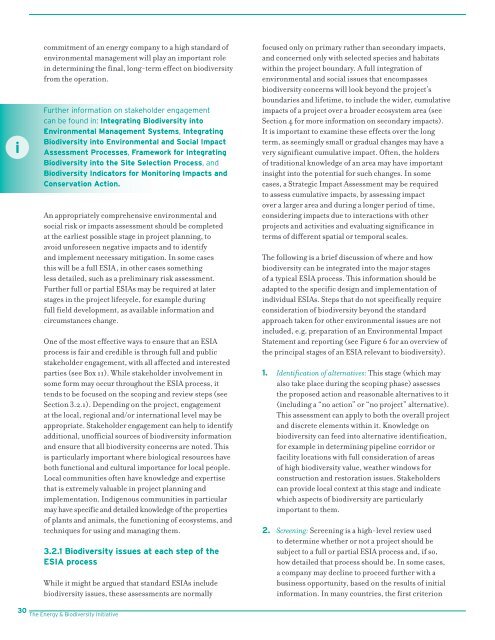Integrating Biodiversity Conservation into Oil and Gas ... - EBI
Integrating Biodiversity Conservation into Oil and Gas ... - EBI
Integrating Biodiversity Conservation into Oil and Gas ... - EBI
Create successful ePaper yourself
Turn your PDF publications into a flip-book with our unique Google optimized e-Paper software.
i<br />
commitment of an energy company to a high st<strong>and</strong>ard of<br />
environmental management will play an important role<br />
in determining the final, long-term effect on biodiversity<br />
from the operation.<br />
Further information on stakeholder engagement<br />
can be found in: <strong>Integrating</strong> <strong>Biodiversity</strong> <strong>into</strong><br />
Environmental Management Systems, <strong>Integrating</strong><br />
<strong>Biodiversity</strong> <strong>into</strong> Environmental <strong>and</strong> Social Impact<br />
Assessment Processes, Framework for <strong>Integrating</strong><br />
<strong>Biodiversity</strong> <strong>into</strong> the Site Selection Process, <strong>and</strong><br />
<strong>Biodiversity</strong> Indicators for Monitoring Impacts <strong>and</strong><br />
<strong>Conservation</strong> Action.<br />
An appropriately comprehensive environmental <strong>and</strong><br />
social risk or impacts assessment should be completed<br />
at the earliest possible stage in project planning, to<br />
avoid unforeseen negative impacts <strong>and</strong> to identify<br />
<strong>and</strong> implement necessary mitigation. In some cases<br />
this will be a full ESIA, in other cases something<br />
less detailed, such as a preliminary risk assessment.<br />
Further full or partial ESIAs may be required at later<br />
stages in the project lifecycle, for example during<br />
full field development, as available information <strong>and</strong><br />
circumstances change.<br />
One of the most effective ways to ensure that an ESIA<br />
process is fair <strong>and</strong> credible is through full <strong>and</strong> public<br />
stakeholder engagement, with all affected <strong>and</strong> interested<br />
parties (see Box 11). While stakeholder involvement in<br />
some form may occur throughout the ESIA process, it<br />
tends to be focused on the scoping <strong>and</strong> review steps (see<br />
Section 3.2.1). Depending on the project, engagement<br />
at the local, regional <strong>and</strong>/or international level may be<br />
appropriate. Stakeholder engagement can help to identify<br />
additional, unofficial sources of biodiversity information<br />
<strong>and</strong> ensure that all biodiversity concerns are noted. This<br />
is particularly important where biological resources have<br />
both functional <strong>and</strong> cultural importance for local people.<br />
Local communities often have knowledge <strong>and</strong> expertise<br />
that is extremely valuable in project planning <strong>and</strong><br />
implementation. Indigenous communities in particular<br />
may have specific <strong>and</strong> detailed knowledge of the properties<br />
of plants <strong>and</strong> animals, the functioning of ecosystems, <strong>and</strong><br />
techniques for using <strong>and</strong> managing them.<br />
3.2.1 <strong>Biodiversity</strong> issues at each step of the<br />
ESIA process<br />
While it might be argued that st<strong>and</strong>ard ESIAs include<br />
biodiversity issues, these assessments are normally<br />
focused only on primary rather than secondary impacts,<br />
<strong>and</strong> concerned only with selected species <strong>and</strong> habitats<br />
within the project boundary. A full integration of<br />
environmental <strong>and</strong> social issues that encompasses<br />
biodiversity concerns will look beyond the project’s<br />
boundaries <strong>and</strong> lifetime, to include the wider, cumulative<br />
impacts of a project over a broader ecosystem area (see<br />
Section 4 for more information on secondary impacts).<br />
It is important to examine these effects over the long<br />
term, as seemingly small or gradual changes may have a<br />
very significant cumulative impact. Often, the holders<br />
of traditional knowledge of an area may have important<br />
insight <strong>into</strong> the potential for such changes. In some<br />
cases, a Strategic Impact Assessment may be required<br />
to assess cumulative impacts, by assessing impact<br />
over a larger area <strong>and</strong> during a longer period of time,<br />
considering impacts due to interactions with other<br />
projects <strong>and</strong> activities <strong>and</strong> evaluating significance in<br />
terms of different spatial or temporal scales.<br />
The following is a brief discussion of where <strong>and</strong> how<br />
biodiversity can be integrated <strong>into</strong> the major stages<br />
of a typical ESIA process. This information should be<br />
adapted to the specific design <strong>and</strong> implementation of<br />
individual ESIAs. Steps that do not specifically require<br />
consideration of biodiversity beyond the st<strong>and</strong>ard<br />
approach taken for other environmental issues are not<br />
included, e.g. preparation of an Environmental Impact<br />
Statement <strong>and</strong> reporting (see Figure 6 for an overview of<br />
the principal stages of an ESIA relevant to biodiversity).<br />
1. Identification of alternatives: This stage (which may<br />
also take place during the scoping phase) assesses<br />
the proposed action <strong>and</strong> reasonable alternatives to it<br />
(including a “no action” or “no project” alternative).<br />
This assessment can apply to both the overall project<br />
<strong>and</strong> discrete elements within it. Knowledge on<br />
biodiversity can feed <strong>into</strong> alternative identification,<br />
for example in determining pipeline corridor or<br />
facility locations with full consideration of areas<br />
of high biodiversity value, weather windows for<br />
construction <strong>and</strong> restoration issues. Stakeholders<br />
can provide local context at this stage <strong>and</strong> indicate<br />
which aspects of biodiversity are particularly<br />
important to them.<br />
2. Screening: Screening is a high-level review used<br />
to determine whether or not a project should be<br />
subject to a full or partial ESIA process <strong>and</strong>, if so,<br />
how detailed that process should be. In some cases,<br />
a company may decline to proceed further with a<br />
business opportunity, based on the results of initial<br />
information. In many countries, the first criterion<br />
30 The Energy & <strong>Biodiversity</strong> Initiative
















![[PDF] Community Development Toolkit - CommDev](https://img.yumpu.com/48616495/1/184x260/pdf-community-development-toolkit-commdev.jpg?quality=85)
